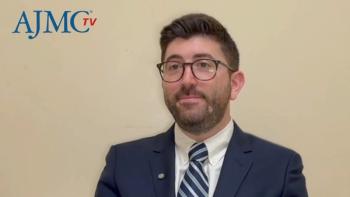
Dr Steven Pipe: What to Watch for in the Hemophilia Therapy Pipeline
The field of hemophilia therapy is advancing, with hemostatic rebalancing agents and gene therapy expected over the next year, said Steven W. Pipe, MD, a professor of pediatrics and pathology at the University of Michigan, Ann Arbor and medical director of the Pediatric Hemophilia and Coagulation Disorders Program and medical director of the Special Coagulation Laboratory.
The field of hemophilia therapy is advancing, with hemostatic rebalancing agents and gene therapy expected over the next year, said Steven W. Pipe, MD, a professor of pediatrics and pathology at the University of Michigan, Ann Arbor and medical director of the Pediatric Hemophilia and Coagulation Disorders Program and medical director of the Special Coagulation Laboratory. He is also chair of the Medical and Scientific Advisory Council to the National Hemophilia Foundation.
Transcript
Can you describe some of the treatment options for hemophilia or other rare blood conditions that are not approved yet, but are anticipated for FDA approval within the next year or so?
The foundational problem of patients’ hemophilia is they're at risk for bleeding and particularly severe bleeding into not just soft tissues, but primarily into joints. We call these hemarthroses. Not only do these have acute problems of severe pain and debility, but they can induce an arthropathy that is progressive over the lifespan. Without the ability to prevent joint bleeds, the destiny for a patient with severe hemophilia is that they will end up with a severe hemophilic arthropathy with loss of range of motion, chronic pain and severe disability. What we've been doing for decades is to replace the missing clotting factor. If you have factor VIII deficiency, we want to give you factor VIII, if you have factor VIIII deficiency, we want to give you clotting factor VIIII. In the early days going back to the 1970s, we were able to fractionate those clotting factors from human plasma donors. But since the 1990s, we've had availability of a recombinant version of both factor VIII and factor VIIII. That platform has allowed us to do bioengineering of the molecules and try to improve some of the characteristics of the protein.
The most effective innovation has actually been to modulate the pharmacokinetics of the factor VIII or factor VIIII. We now have what are called extended half-life factors, which lasts longer in circulation after infusion. All the factor concentrates have to be delivered intravenously. Even with the extended half-life agents, the half-life is still short enough that, on average, patients have to dose about every other day with factor VIII products, maybe as long as once a week with the longer acting factor VIIII products. That's still a tremendous burden, if you think about from early childhood, all the way through the rest of your life, to have to rely on an IV access.
One of the greatest innovations in my time caring for patients has been the availability of a of a new substitution therapy for factor VIII. Now, this only works for hemophilia A, but this is a bispecific antibody. It's a monoclonal antibody, it's been humanized, and it substitutes for the clotting function of factor VIII in the body. The beauty of this molecule is it's highly bioavailable, so you can give it subcutaneously, and because it's a monoclonal antibody, it lasts in circulation a really long time, about 30 days. The dosing regimens with this bispecific antibody called emicizumab is once a week, once every 2 weeks, or even once every 4 weeks. The other beauty of this molecule is it doesn't look anything like factor VIII, but it substitutes for it. About 30% of our patients with severe hemophilia develop antibodies directed against the factory molecule and then we can't use that form of therapy anymore. This bispecific antibody, because it doesn't look like factor VIII, is not neutralized by those inhibitor antibodies. This is a prophylactic therapy that can be used whether or not you have a history of an inhibitor. It's greatly revolutionized the care for patients. We can use it all the way from infants all the way through adulthood. This lower burden of administration has really transformed the lives for patients.
There's a whole other category of what we call hemostatic rebalancing agents, which is coming in the pipeline. If you think about your blood clotting system, as procoagulant on one side of the balance and anticoagulants on the other, when you have hemophilia, you're missing an anticoagulant. So, it tilts the balance so that you have a bleeding disorder. We rebalance with procoagulant, like factor VIII or factor VIIII, but we can also rebalance by targeting the natural anticoagulants. There's 3 natural anticoagulants in our blood clotting system, antithrombin, activated protein C, and something called tissue factor pathway inhibitor. It turns out that each of those natural anticoagulants has a biologic target that's being investigated in the clinics. By either neutralizing those functions or knocking down their activity or the levels, it shows a rebalancing of the hemostatic system. We've explored this now in hemophilia, and it looks like these can be effective prophylactic agents, even without giving factor VIII or factor VIIII.
The other beauty of this class of agents, because they work on the natural anticoagulants, they are effective for patients with hemophilia A, hemophilia B, with or without inhibitors. It’s like a cross-platform type of therapy. I think if these get approved, these will also have the advantages of subcutaneous delivery, steady state hemostatic effect, and long duration, so the intensity of the burden of administration will be quite low.
What I had an opportunity to talk about today was the imminent advent of gene therapy for the hemophilias. If we think about the concept of hemophilia as a monogenic disease, you just have a mutation that's blocking you from expressing factor VIII or factor VIIII. It seems like a nice model, if we could just give you a new functional copy of the factor VIII or factor VIIII gene, and then your own body would be able to make the protein and hopefully, that would restore your blood clotting. We've realized that now, with the current platform of gene therapy, the trick is how do you get the gene, or what we call the transgene, into an organ that's capable of making the clotting factors? What we've settled on is a viral vector delivery system that uses a nonpathogenic virus called the adeno-associated virus. That becomes the sort of packaging for what we want to deliver, which is a copy of the factor VIII or factor VIIII gene. This goes into a patient through a short intravenous infusion, as short as 1 to 3 hours in the outpatient setting. The viral vector homes to the liver, gets taken up by the liver cells, and then the vector particle gets directed to the nucleus where it delivers the payload, and with this case, the factor VIII or factor VIIII gene. Then, the patient's own liver cells start to make the factor VIII or the factor VIIII protein.
This has been effective. It works in the vast majority of patients who have received this. There are some challenges that we're working out through the clinical trial processes, but we have long-term correction of blood clotting in patients with hemophilia A as long as 5 years out from this treatment, and as long as 10 years out for hemophilia B. This is a potentially transformative therapy. You no longer have to do prophylaxis with clotting factors, and we've been able to achieve levels that, for the vast majority of the recipients, they don't have any breakthrough bleeding events. I'm excited there's a platform that is before the FDA right now for both hemophilia A as well as for hemophilia B, and I fully expect that next year, we should have products that we'll be delivering through commercial gene therapy in our clinics.
Newsletter
Stay ahead of policy, cost, and value—subscribe to AJMC for expert insights at the intersection of clinical care and health economics.









































